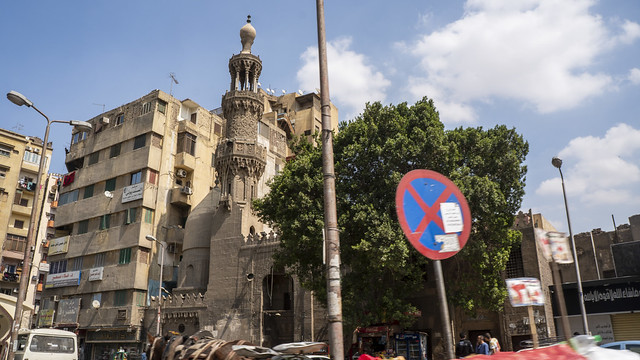There are good reasons why UNESCO chose Historical Cairo as a World Heritage site.
One of those reasons I believe personally is that Cairo is one of those cities where you can see a long history, a long tale of man since the dawn of history till our modern time manifested in architecture; even if those buildings are tombs and cemeteries.
I can’t drag myself to write what is happening at Cairo’s City of the Dead because the whole thing depresses me and if I go deeper, I will be depressed more. “More about it from AP”
Reading what happened to the cemetery of legendary Egyptian journalist and novelist Ihsan Abdel Kouddous by the pen of his grandson Sharif Abdel Kouddous made me feel helpless.
Cairo’s City of the Dead included some of Egypt’s greatest pioneers in the 19th and 20th century like Abdel Kouddous.
It shocked me how the Ministry of Archeology and Tourism officials from archaeologists justified this disrespect to the deceased and how they regarded those cemeteries as “modern”.
They should know better.
Some of those cemeteries were designed and constructed by the brightest architects Egypt and the Arab world have seen till this day like Hassan Fathy.
I knew that in the 1980s or the 1990s, a similar project was proposed and planned during Mubarak era but Dr Galila El-Kady, the first Egyptian woman to survey and write down the history of the Cairo's City of the Dead stood against the project and succeeded in stopping it but now another project is here and it seems Goliath is winning.
El-Kady made important books about the history of Cairo in English and French above them “Architecture for the Dead: Cairo’s Medieval Necropolis”
Some people supported online the government in those highways plan to claim that those modern “Mamluks” useless places, a highway is much better.
Other claims that there is no history in those places, unfortunately, some regard that history in Egypt stops at the ancient Egyptian era as well as what the government renovates only.
“It is a 19th-century building, it is not historical,” They say or “It is just building”
Sometimes you are captured by the beauty of a villa or a cemetery entrance or a mosque and you ask more about it and its history to know that the owner of the cemetery was a famous Egyptian politician or a famous doctor or an industrialist who contributed a lot to the history of the industry in this country away from foreign control.
Back to the starting point, why UNESCO considered historical Cairo including Islamic Cairo a World Heritage Site.
An Exhibit below from very few photos can explain my point when it comes to Historical Islamic Cairo
Those are some of the mosques I found on the way from the Mosque of El-Sayida Zeinab to the Islamic Museum in Port Said street.
I took their photos while I was in the car and I returned to read more about them only to find names I have not known before.
Prince Tamraz Mosque from the Mamluk era
 |
| Prince Tamraz Mosque |
This is the Mosque of Mamluk Prince Tamraz built in the year 1471 during the era of Sultan Qaitbay.
What we know about late Prince Tamraz was that he was a Circassian slave boy that was purchased and enrolled in Egypt’s Mamluk system. Soon, he became a leading Mamluk from the ruling class that controlled Egypt and Levants in several centuries. There had been renovations that took place in the mosque in 18th and 19th century.
You can find more in Egy.Com
Prince Mangak Al-Yusufi Mosque from the Mamluk Era
Built by Mamluk Prince Mangak Al-Yusufi in the 14th century.
Prince Mangak was a prominent prince in the reign of Sultan Al-Nassar Mohamed Ibn Qalawun
 |
| Prince Mangak Al-Yusufi Mosque |
I thought that the Mosque was from the Ottoman era because of its minaret but I was wrong. The Mosque built by Prince Mangak Al-Yusufi
Fadel Pasha Mosque and its distinguished minaret.
 |
| Fadel Pasha Mosque |
This mosque was built by Mamluk Prince Seif El-Din Bashtak in the 14th century during the era of Sultan Al-Nasser Mohamed Ibn Qalawun
It was renovated after another 400 years in the 18th century and nearly was reconstructed by members of Mohamed Ali Royal Family and named after Khedive Ismail’s brother Fadel Pasha
 |
Fadel Pasha Mosque Another shot showing the minaret. |
Prince Yusuf Agha Hanin Mosque
 |
| Prince Yusuf Agha Hanin Mosque |
Built during the Mamluk era.
It was built in the 16th century by Mamluk Prince Yusuf Agha Hanin who descended from Circassian roots.
The reflection of the car’s windshield is obvious in this shot.
FYI, I know that this post you will find things are unrelated but I feel angry, depressed and helpless.
Sometimes you are willing to do so and to write because it may bring change, other times you feel drained and exhausted to the level you can’t fight anymore.
Some times you wonder what the point of this.
Maybe, this is just proof that in our time we tried to do something right and save part of our heritage.

No comments:
Post a Comment
Thank You for your comment
Please keep it civilized here, racist and hateful comments are not accepted
The Comments in this blog with exclusion of the blog's owner does not represent the views of the blog's owner.